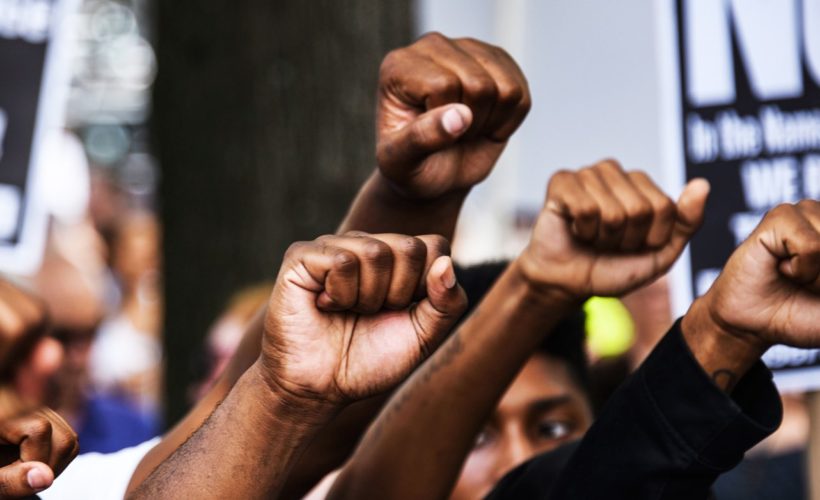Two days before the 2016 presidential election, @woke_blacks posted an anti-voting polemic to its Instagram account. “The excuse that a lost Black vote for Hillary is a Trump win is bs. Should you decide to sit-out the election, well done for the boycott,” the caption read. “I remind us all one more time, anyone who wins can literally change less about the state of Black people, we are on our own, esp. after Obama. Wise up my people!” Another user, @afrokingdom_, shared a comparable sentiment: “Black people are smart enough to understand that Hillary doesn’t deserve our votes! DON’T VOTE!”
According to a new report commissioned for the Senate Intelligence Committee by cybersecurity firm New Knowledge, those accounts, along with dozens more, were part of an extensive and complex campaign to suppress the black American vote by the Russian firm Internet Research Agency.
In late 2017, it was first reported by CNN that the pro-Kremlin enterprise masterminded a plot to infiltrate online communities of the Black Lives Matter movement. But New Knowledge’s report, released Monday, shows a much more sustained and purposeful focus on black Americans—as the IRA went about instigating mistrust in law enforcement and political institutions, while cultivating seemingly authentic narratives of black pride.
The report details how black Americans were among the most exploited online communities by the IRA, cataloging how the Russian firm developed an “expansive cross-platform media mirage” that specifically targeted black people by leveraging popular social media sites. The campaign was “designed to exploit societal fractures” and “erode our trust in media entities and the information environment, in government, in each other, and in democracy itself,” the report states. “This campaign pursued all of those objectives with innovative skill, scope, and precision.”
The 100-page report is based on data sets provided to the Senate by Facebook, Twitter, and Alphabet, comprising tens of thousands of posts between 2015 and 2017. In addition to social media sites, the IRA’s vast and varied disinformation campaign played out across issue-specific domains that they bought such as blackmattersus.com, black4black.info, and blacksoul.us—“a complex effort” to manipulate public opinion with the intention of siphoning votes from Hillary Clinton to help elect Donald Trump. The black community, often a reliably strong voting bloc for Democrats, was a substantial target.
Spread among Facebook pages, Instagram accounts, Twitter accounts, and YouTube channels, the IRA’s tactics ranged from ad targeting, meme warfare, video manipulation, and the creation of sham account profiles. As my WIRED colleagues point out, much of this content was designed to encourage a lack of faith among black Americans in democratic institutions and decelerate black turnout for Clinton. “As the election became imminent,” the New Knowledge report says, “those themes were then tied into several varieties of voter suppression narratives: don’t vote, stay home, this country is not for Black people, these candidates don’t care about Black people.” (A second report, also produced for the Senate, by Oxford University’s Computational Propaganda Project and Graphika comes to similar conclusions about the IRA’s work, according to the Washington Post.)
One of the more fascinating bits from the New Knowledge report was YouTube’s role as an influence platform. Of the 1,107 videos linked to the IRA, the majority of the content—96 percent, according to researchers—centered on Black Lives Matter and police brutality. A video by Williams & Kalvin, titled “The truth about elections,” is cited as one of the more “overt suppression narratives” employed by an IRA-affiliated entity. In another instance, the IRA co-opted a human-interest story about “an inspirational young Black American who made the national news for a device he invented.” The IRA accounts repurposed that story across its web of counterfeit accounts with messages meant to cultivate distrust in American society: “These are stories of Black children the media don’t want you to see” and “White people invent tools for killing, this Black child is inventing a tool for saving lives.”
Of the Russian firm’s race-specific domains, Blackmatters.us was perhaps the most effective in amplifying the IRA’s intended media mirage. It essentially operated like a digital marketing company as it built an online presence across multiple platforms, creating various accounts to reinforce its brand and distribute content wholesale. Their strategy took on real-world resonance in other instances, as well, as they instituted recruitment efforts. “Posts encouraging Americans to perform various types of tasks for IRA handlers appeared in Black, Left, and Right-targeted groups,” the report states, noting that such efforts had the biggest presence in black communities. “Many posts solicited protestors, writers, activists, lawyers, and photographers to attend the property’s numerous events. They posted job ads for real American writers to create content … a clear example supporting the hypothesis that the IRA engaged in narrative laundering.”
When reports of Russian infiltration into the Black Lives Matter movement first emerged, I wrote that urgent social and political crusades have historically attracted noxious efforts to infiltrate and dismantle them. The deeper reasons behind such a ploy are as unsurprising as they are obvious: black liberation movements have faced a constant and public threat from outside detractors for decades. And the tactic of exploiting racial tension in the US has specifically Russian precedent that extends back to even before the Cold War, as Julia Ioffe wrote in The Atlantic last year.
The weaponization of memes were a crucial element in the IRA’s crusade, too. Black online communities were particularly targeted with memes concerning “distinct historical conspiracies … intended to reinforce cultural identity as well as create discord.” Posts that claimed classical composer Mozart was actually black and that Shakespeare’s plays were written by a black woman earned enough engagement that accounts used them repeatedly. And the report details that the IRA’s activity on Instagram was much more extensive than previously reported, with even more engagement than on Facebook.
That the IRA found success in these campaigns, to a degree, is not surprising. They saw the United States for what it was, for how it has, on the whole, historically treated black Americans, and decided to exploit that history of injustice. They grafted their strategy onto a scaffolding that is very much made in the USA: long-festering racial tensions; policing issues born out of cities like Ferguson and Oakland; a mainstream media that has excluded voices of color and therefore lends itself to not being trusted by communities it doesn’t represent, ultimately leading people to seek out alternative outlets.
In the end, the IRA went to great lengths to siphon power from black voters, with a mixed-media, cross-platform strategy that researchers are still working to fully understand. And despite efforts by Facebook, Twitter, Alphabet, and other companies to eradicate such content from their platforms, distortion tactics by the IRA persist today. “The narratives,” the researchers write, “just evolved.”
More Great WIRED Stories
- Everything you want to know about the promise of 5G
- How WhatsApp fuels fake news and violence in India
- Blu-rays are back to prove that streaming isn’t everything
- An Intel breakthrough rethinks how chips are made
- 9 Trumpworld figures who should fear Mueller the most
- ? Looking for the latest gadgets? Check out our picks, gift guides, and best deals all year round
- ? Get even more of our inside scoops with our weekly Backchannel newsletter
Source:WIRED










